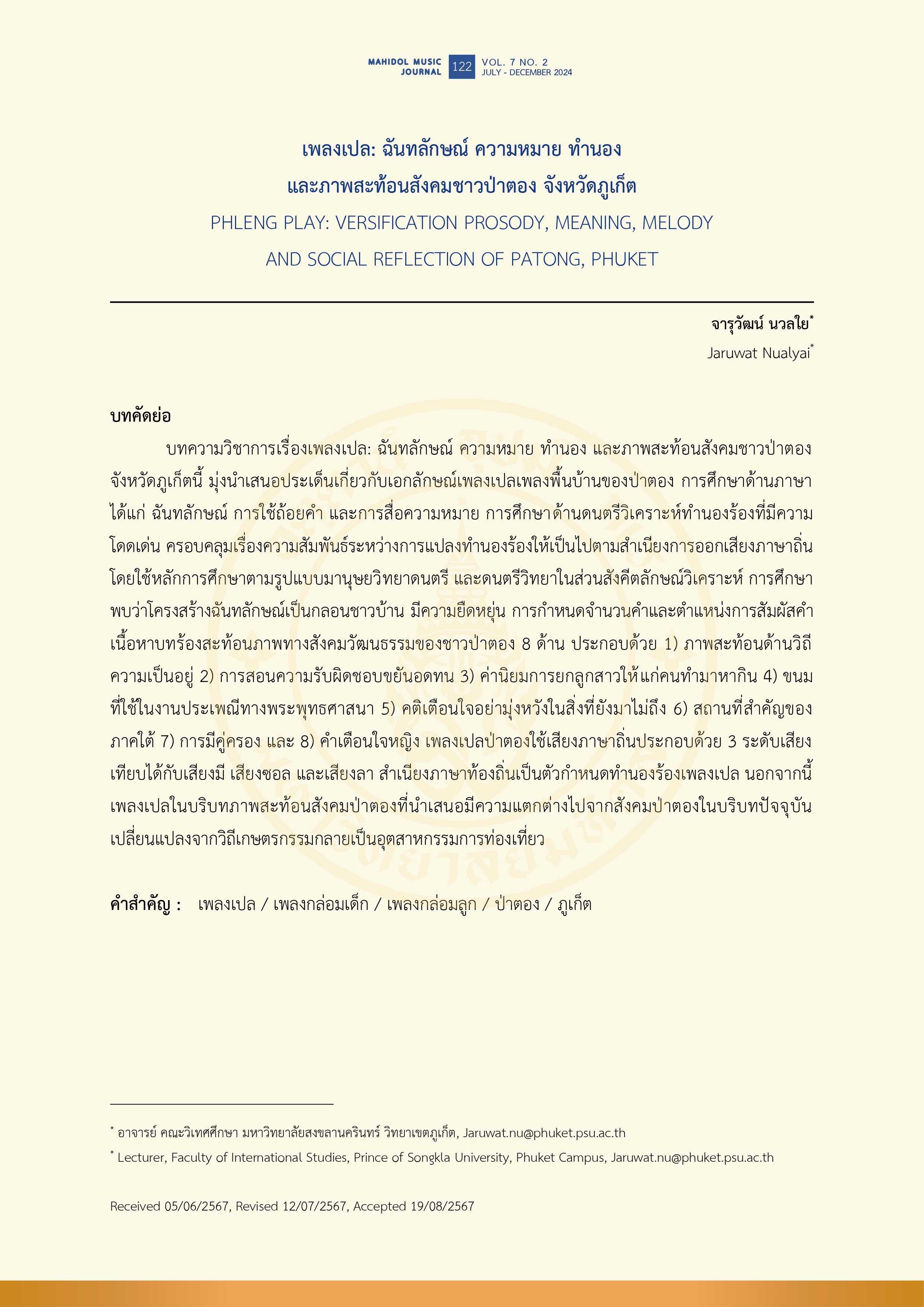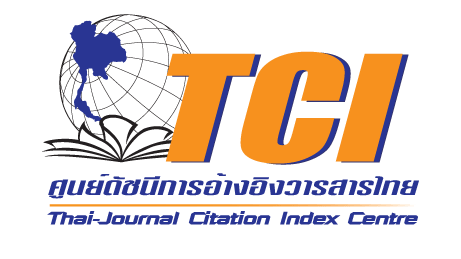PHLENG PLAY: VERSIFICATION PROSODY, MEANING, MELODY AND SOCIAL REFLECTION OF PATONG, PHUKET
Keywords:
Phleng Play, Lullaby, Patong, PhuketAbstract
This academic article was to argue for the folk song, Pleang Play, which is a uniqueness to Patong subdistrict in Phuket. The purpose of the study were to analyze the prosody, word using, and meaning of the lyrical texts. Additionally, the article examined melodic analysis in music study, including modifying melody based on the local dialect. Both musicological and ethnomusicological methods were employed in this study. The result revealed that local prosody was used in the creation of Pleang Play, and words were formed flexibly. In the Social reflections uncovered 8 cultural implications, including 1) Way of living, 2) Moral conceptions of duty, 3) Marrying off daughters to decent men, 4) Desserts used in Buddhist traditions, 5) Future inspiration instilled, 6) Places in Southern Thailand, 7) Family life and 8) Idioms for teaching women. Furthermore, the singing techniques relied on the local dialect especially for tone and melody. The three distinct sounds – note Mi, Sol and La – that made up the tonic points (main sounds) of the song, were what hung on the tone marks (Wannayuk). Consequently, from a sociological perspective, Pleang Play has effectively depicted the significant shift in Patong’s social milieu from an agrarian to an industrialised tourism society.References
Amatayakul, Poonpit. Music Appreciation: Basic Knowledge of Thai Music for Appreciation. Bangkok: Raksipp, 1986. (in Thai)
Chimnoo, Supaporn, Poonpit Amatyakul, and Nachaya Natchanawakul. "Studies of the Southern Lullaby, Je-Hay Dialect (Tak-Bai-Tumpat)." Humanities Journal 25, no. 1 (January-June 2018): 133-154. (in Thai)
Culler, Jonathan. Literary Theory: A Very Short Introduction. Translated by Sunanta Wannasin Bell. Bangkok: Bookscape, 2018. (in Thai)
Kunanurak, Mullika. Lullaby songs for Southern Thai Muslims. Yala: Soem Printing, 1981. (in Thai)
Ketsiri, Kamol. Music in Thai. Bangkok: Prakaipruek, 1984. (in Thai)
Pakmaluk, Satit. “I-San Local Wisdom From Lullaby Ethnic Thai Lao, Thai Yoy, Phuthai, and Thai Nyaw in Sakon Nakhon Province.” Chophayom Journal 26, no.1 (January-June 2015): 23-34. (in Thai)
Parphatsorn, Phatooramphai. "Use of Nakhon Tritrueng Storytelling for Identity Building in Public Relations Work of Kamphaeng Phet Province." Journal of Management Science Pibulsongkram Rajabhat University 5, no. 1 (January-April 2023): 15-31. (in Thai)
Pinphuttasin, Sommai. Phuket's Local Literature. Phuket: Phuket Cultural Center, 1989. (in Thai)
Thongsakul, Rungrat. "Lullabies: Reflections Related to the Culture of Lamphi Subdistrict, Thai Mueang District, Phang Nga Province." Journal of Roi Et Rajabhat University 15, no. 3 (September-December 2021): 134-143. (in Thai)
Tkach, Anna. "Lullaby Songs and Their Role in the Context of Traditional Culture." Accessed May 10, 2020. https://doi.org/10.31866/2616-7581.3.2.2020.219168.
Traiyawong, Kongkrit. "Paul Ricoeur on Narrative Identity." Master's thesis, Chulalongkorn University, 2007. (in Thai)
Wongsatayanont, Charn. Tourism Log of Phuket Province. Bangkok: Rongpim Thongkamol, 2009. (in Thai)
Yodto, Raphin. Stories from The Elders. Phuket: Patong Municipal Education Office, 2009. (in Thai)

Downloads
Published
How to Cite
Issue
Section
License
Copyright (c) 2024 College of Music

This work is licensed under a Creative Commons Attribution-NonCommercial-NoDerivatives 4.0 International License.
The copyright of the article belongs to the author. Published articles represent the views of the authors. The editorial team neither necessarily agree with nor take any responsibility for the article.





